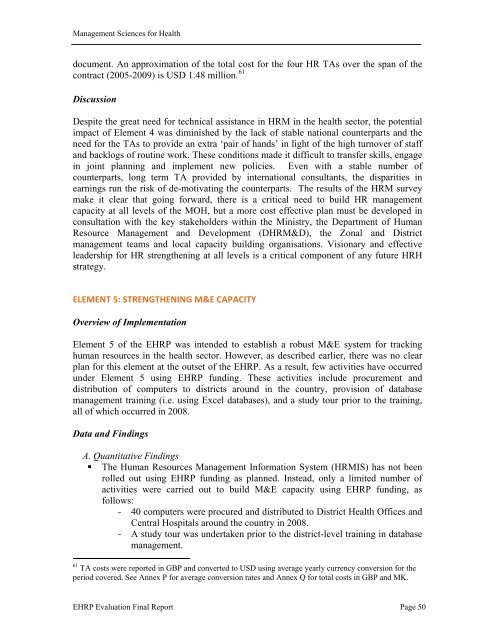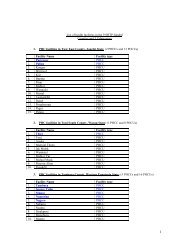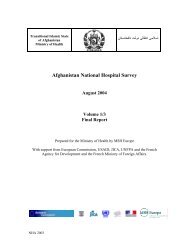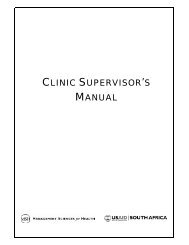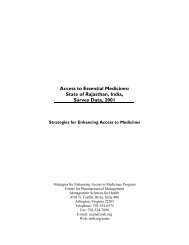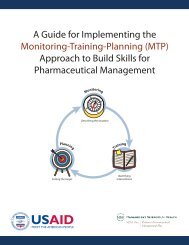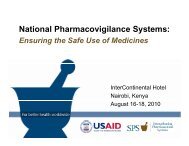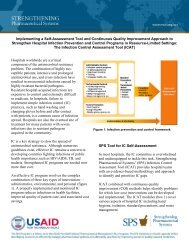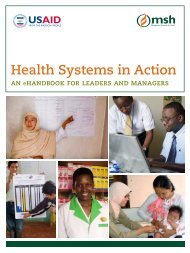Evaluation of Malawi's Emergency Human Resources Programme
Evaluation of Malawi's Emergency Human Resources Programme
Evaluation of Malawi's Emergency Human Resources Programme
You also want an ePaper? Increase the reach of your titles
YUMPU automatically turns print PDFs into web optimized ePapers that Google loves.
Management Sciences for Health<br />
document. An approximation <strong>of</strong> the total cost for the four HR TAs over the span <strong>of</strong> the<br />
contract (2005-2009) is USD 1.48 million. 61<br />
Discussion<br />
Despite the great need for technical assistance in HRM in the health sector, the potential<br />
impact <strong>of</strong> Element 4 was diminished by the lack <strong>of</strong> stable national counterparts and the<br />
need for the TAs to provide an extra ‘pair <strong>of</strong> hands’ in light <strong>of</strong> the high turnover <strong>of</strong> staff<br />
and backlogs <strong>of</strong> routine work. These conditions made it difficult to transfer skills, engage<br />
in joint planning and implement new policies. Even with a stable number <strong>of</strong><br />
counterparts, long term TA provided by international consultants, the disparities in<br />
earnings run the risk <strong>of</strong> de-motivating the counterparts. The results <strong>of</strong> the HRM survey<br />
make it clear that going forward, there is a critical need to build HR management<br />
capacity at all levels <strong>of</strong> the MOH, but a more cost effective plan must be developed in<br />
consultation with the key stakeholders within the Ministry, the Department <strong>of</strong> <strong>Human</strong><br />
Resource Management and Development (DHRM&D), the Zonal and District<br />
management teams and local capacity building organisations. Visionary and effective<br />
leadership for HR strengthening at all levels is a critical component <strong>of</strong> any future HRH<br />
strategy.<br />
ELEMENT 5: STRENGTHENING M&E CAPACITY<br />
Overview <strong>of</strong> Implementation<br />
Element 5 <strong>of</strong> the EHRP was intended to establish a robust M&E system for tracking<br />
human resources in the health sector. However, as described earlier, there was no clear<br />
plan for this element at the outset <strong>of</strong> the EHRP. As a result, few activities have occurred<br />
under Element 5 using EHRP funding. These activities include procurement and<br />
distribution <strong>of</strong> computers to districts around in the country, provision <strong>of</strong> database<br />
management training (i.e. using Excel databases), and a study tour prior to the training,<br />
all <strong>of</strong> which occurred in 2008.<br />
Data and Findings<br />
A. Quantitative Findings<br />
� The <strong>Human</strong> <strong>Resources</strong> Management Information System (HRMIS) has not been<br />
rolled out using EHRP funding as planned. Instead, only a limited number <strong>of</strong><br />
activities were carried out to build M&E capacity using EHRP funding, as<br />
follows:<br />
- 40 computers were procured and distributed to District Health Offices and<br />
Central Hospitals around the country in 2008.<br />
- A study tour was undertaken prior to the district-level training in database<br />
management.<br />
61 TA costs were reported in GBP and converted to USD using average yearly currency conversion for the<br />
period covered. See Annex P for average conversion rates and Annex Q for total costs in GBP and MK.<br />
EHRP <strong>Evaluation</strong> Final Report Page 50


